How To Improve Contrast On A Microscope

Microscope Contrast Techniques
When using a microscope with brightfield, some samples will have a natural contrast that is easily viewed, such as bright plants and flowers, metals, and pigments. Some samples can exist stained to increase the microscope dissimilarity. Notwithstanding, low contrast samples such as unstained leaner, sparse tissue slices, live cells, or reflective metal parts require the apply of boosted microscope contrast techniques in club to view the sample. Here we volition explore each of these different microscopy contrasting techniques.
Pinnacle vii Microscope Contrast Techniques:
- Darkfield
- Phase Dissimilarity
- Polarization
- Fluorescence
- Oblique Illumination
- Differential Interference Dissimilarity (DIC)
- Improved Hoffman Modulation Contrast (iHMC)
Darkfield Microscopy
When using darkfield microscopy, no calorie-free from the illuminator will pass into the imaging organisation, only light diffracted by the construction is captured by the objective. This is what makes the structures appear rich in contrast, and very bright confronting a dark background. Darkfield microscopy is particularly useful to find tiny and isolated structural details, such as bacteria. When working with reflected light, darkfield illumination is used to place grain boundaries in polished and etched metallic sections, as well as to detect contaminants and flaws in surfaces.
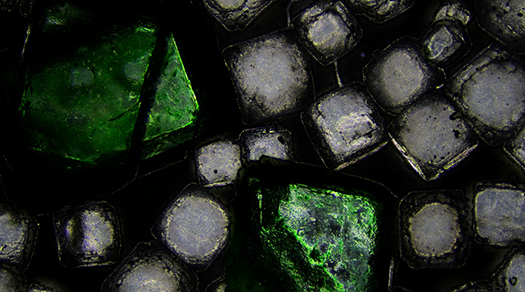
This image of table salt was captured using a darkfield slider on the Zeiss Primostar 3 microscope.
Stage Dissimilarity Microscopy
When using a brightfield microscope, sparse and transparent samples accept a very depression contrast and can be barely visible. Phase contrast microscopy is the method of choice for viewing thin, unstained samples such as culture cells. Phase dissimilarity uses a special condenser and objective lenses to enhance the dissimilarity seen in the microscope image. Phase contrast is not useful for thick specimens such equally plant or animal tissue sections.
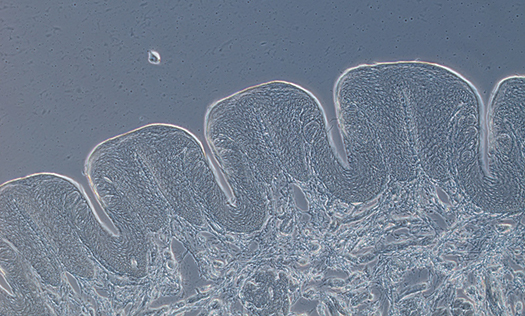
This image of rabbit tastebuds was captured using the Zeiss Primsotar three phase dissimilarity microscope.
Polarization
Polarizing microscopes must be equipped with two crossed polarizers. In most cases at least one polarizer and 1 analyzer are used. Many materials, like most crystals and some biological structures such as muscle cells, are birefringent, meaning they take ii refractive indices. This phenomenon fulfills an of import diagnostic function in mineralogy, pharmacology, forensic microscopy, polymer research, or the quality command of material fibers. Reflected light is used to visualize the contrasts in the origin of structure of opaque metals such every bit aluminum, zirconium, and others.
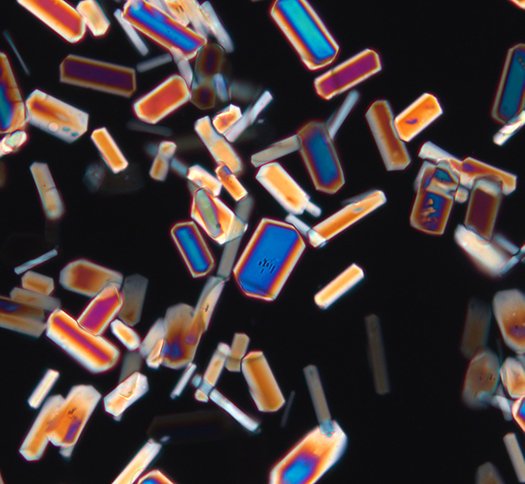
This image of crystals was captured using a polarizing microscope.
Fluorescence Microscopy
Fluorescence is a low-energy course of radiations (emission) that results from a previous high energy illumination (excitation). As soon as the excitation stops, the fluorescence emission stops nigh immediately. The detail advantages of fluorescence microscopy include a strong image contrast and its specificity; that is, its ability to specifically observe private structures downwardly to individual molecules. Fluorescence microscope illuminators oftentimes use gas discharge lamps such as HBO, XBO, HXP or long-life LED calorie-free sources. LEDs make it possible to change the excitation wavelengths extremely quickly. The downside to LED light sources is that they yet exhibit rather depression excitation intensity in sure spectral ranges.
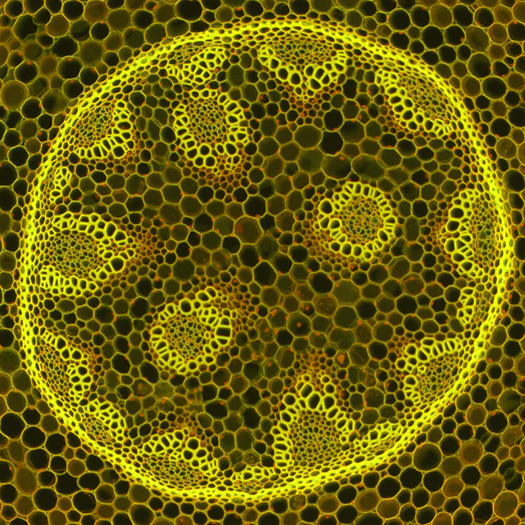
This image of Convallaria (flower) was captured using a fluorescence microscope.
Oblique Illumination
Oblique illumination is recommended to dissimilarity objects that are too thick for culling contrasting techniques. Oblique illumination directs light beams onto the specimen at dissimilar angles. As a result of highly directed one-sided illumination, the sample volition have one side that appears bright and the other darker, which results in a shadow-casting relief epitome showing fine structural details. Oblique illumination microscopy is utilized to view thick tissue samples or solid samples that practice non permit light to pass through them, such as automotive parts.
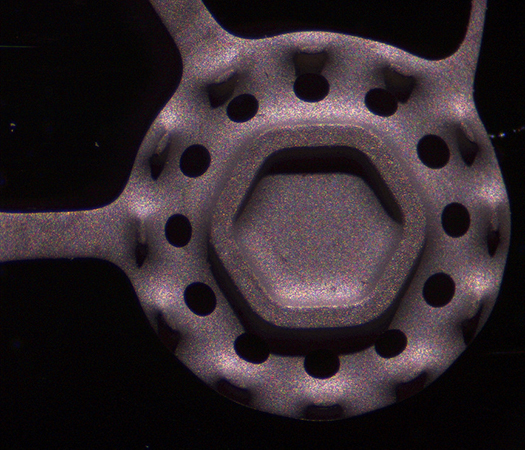
This is an automotive part captured nether the Zeiss Stemi 305 stereo microscope using oblique illumination.
Differential Interference Contrast (DIC) Microscopy
In interference contrast, previously split partial beams are combined as in phase contrast, interfering with each other every bit a effect. Due to the interference of the two twin images in the intermediate image plane, a light-nighttime dissimilarity is generated at the edges of objects. By laterally shifting the objective-sided DIC prism, besides known as the DIC slider, the dissimilarity can be adjusted in such a manner that the light and night object edges appear on a gray background. Every bit the illumination appears darker on one side and brighter on the other side, a pseudo-relief image is perceived by our brain. This tin can - but does not have to - friction match the actual topography of the sample.
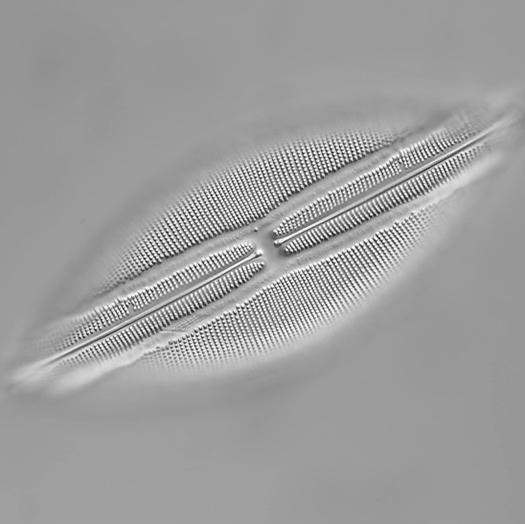
This image of Navicula Lyra (algae) was captured using DIC on the Zeiss Axioscope 5 microscope.
Improved Hoffman Modulation Dissimilarity (iHMC)
Hoffman modulation contrast is a form of oblique transmitted lite illumination in combination with a grayscale modulator comprising neutral greyness absorbing layers mounted in the objective's back focal plane. The modulator consists of three grayscale strips that run vertically through the pupil of the objective. This results in this method's middle gray paradigm background and modulates a relief dissimilarity. iHMC is used in the live-jail cell microscopy of sperm and egg cells when conducting artificial insemination in man and veterinarian medicine.
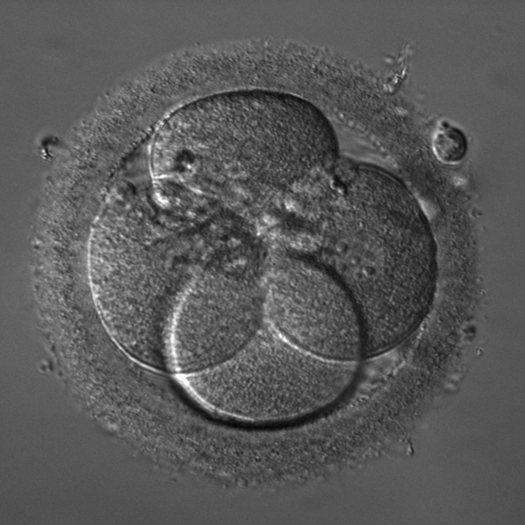
This image of an embryo was captured under the Zeiss Axio Vert A1 microscope using iHMC.
References: Koenen and Zölffel, Microscopy for Dummies, Wiley, 2020.
If you lot have whatever questions about microscope contrasting techniques or which microscope provides the best contrast for your awarding, please contact Microscope Earth.
Related Articles of Involvement:
Different Types of Microscopes and Their Uses
Microscopy Polarization Explained
Darkfield Microscopy Explained
Source: https://www.microscopeworld.com/p-4440-microscope-contrast-techniques.aspx

0 Response to "How To Improve Contrast On A Microscope"
Post a Comment